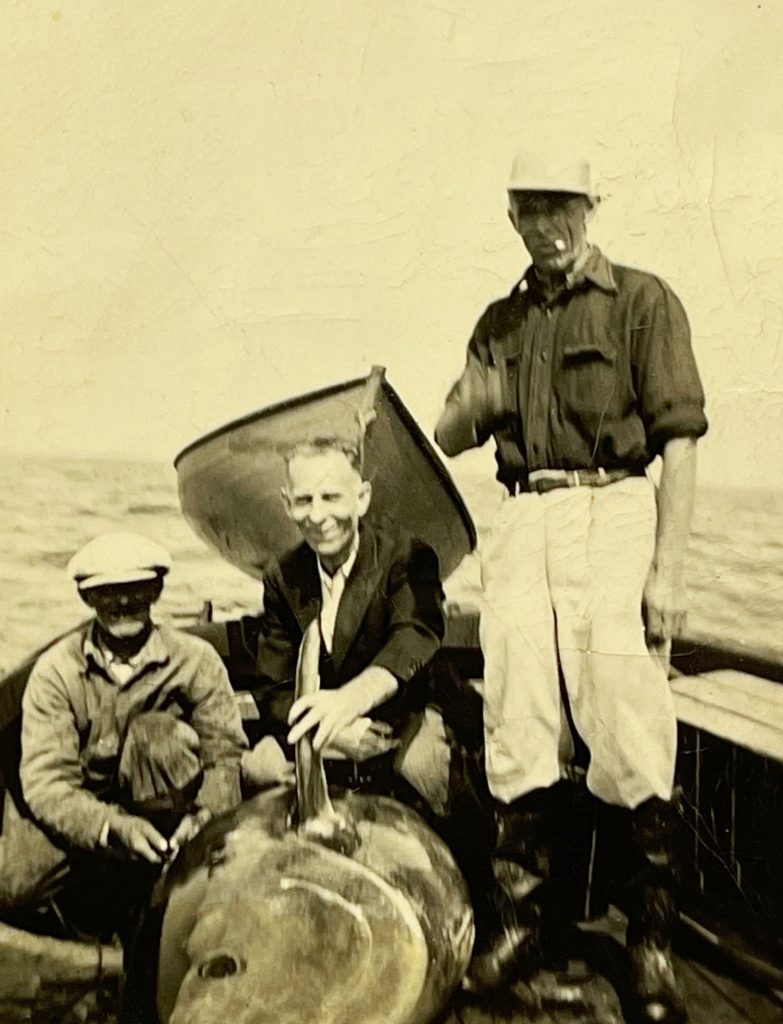Weathering The Storms
[ theme music rises ]
It’s been said that better questions lead us naturally to better answers, and that it’s in not knowing that we open the doorway to knowing. I’m Scott Lennox and you’re listening to The Beautiful Question, a consideration of things that truly matter in a complex world.
[ brief pause ]
Among the many kinds of nautical anchors are the long canvas “buckets” called sea anchors that keep boats pointed into the wind during a storm on the open ocean. My grandfather and his brother never left port without one stowed in the forward hatch.
Join me this week as we consider practical options for weathering adversity without being capsized. Stay with me.
[ brief pause as theme music fades ]

Photographer unknown
Taken in the summer of 1948, this week’s illustration is a photograph of my paternal grandfather straddling a five hundred ninety-eight-pound tuna that he fought for more than four hours out in the Grand Banks using only a wire hand line and a special set of gloves called “nippers.” Pictured with him are his brother Willy and a man who occasionally helped them. We don’t know who took the photograph.
When he was working, my grandfather earned a living by fishing for tuna and catching lobster out in the Atlantic Ocean, sailing out of the small town of Pubnico in Nova Scotia. He and his brother fished aboard the forty-two-foot wooden boat they shared. The craft was typical of the working vessels of the time and are not uncommon today. Compared to the relentless power of the sea, their boat was a small one. The Grand Banks is a harsh place when storms roll in, and anyone who knows the sea has a more than healthy respect for what can happen out there.
My grandfather and his brother were no exceptions. They knew that because wind moves over water faster than boats move through it, no fishing vessel is capable of outrunning a storm. You just can’t do it, no matter how hard you try. When heavy weather approached, their only survivable option was to head straight into it.
[ brief pause ]
To do that, they would cut the engine and point their boat into the wind, drop the sail, then secure the sail and the boom to keep them from swinging from side to side. While one of them was busy doing that, the other would secure the sea anchor to an iron cleat at the bow of the boat and then throw the anchor into the ocean in front of him.
My grandfather’s sea anchor was an elongated canvas “bucket” that was held open at the mouth with a broad iron ring. Wide at the mouth and much narrower at the toe where small slits were cut into it, it pulled hard against the water as the rising wind pushed the boat backwards. Higher and wider in the front than at the stern, the boat was designed to shed wind and waves. Having the sea anchor in place helped the vessel stay pointed to windward during even the heaviest weather.
[ brief pause ]
Once the sail was down and the rudder was locked into place and the sea anchor was doing its job, those aboard would secure everything that could be safely stowed and pitch everything that couldn’t be stowed over the side to minimize the risk of something damaging the boat’s hull as they were tossed about.
Then, with the boat facing the wind, they took what shelter they could in the small wheelhouse and rode it out until the storm eventually weakened. I can still hear my grandfather saying, “All storms pass eventually.”
[ brief pause ]
I’ve learned the hard way that sometimes life on dry land can be just as tumultuous and unpredictable and treacherous as life at sea. I needn’t list for you the hardships and adversities—the “storms”—I’ve faced and come through, nor how badly I was battered from time to time. I’m sure you have a list of your own and stories to recount.
In the same way my horse-riding friends will tell you that “the only folks who don’t fall, don’t ride,” my ocean-going friends will tell you that the only people who don’t experience trials and challenges aboard a boat have never left the harbor and never put to sea. The same can be said of being alive. The only people who don’t struggle from time to time (and sometimes quite strongly) are no longer with us or waiting to be born.
[ brief pause ]
This week, our consideration isn’t about the fact that life brings inevitable challenges and adversity, or that to be alive is to struggle. Our focus is how to best face those things when they happen. Going back to the sea anchor metaphor for a moment, we’ll consider how to stay pointed into the challenge—whatever it may be—and keep from capsizing on the vast and churning ocean of life.
Counseling with hundreds of clients and patients over the years, I’ve asked people what keeps them pointed in the right direction to handle adversity when it presents itself. Some of their answers continue to inspire me.
My mentor in graduate school used to tell me: “See yourself finishing well.” That mental image helped me keep my goal in mind and later helped me stay focused on recovering and becoming healthy again when I went through a major health crisis.
Many clients have shared stories about their faith or particular passages of scripture that keep them focused and give them strength during hard times. I remember hearing Wayne Dyer saying that faith is like the overhead straps that people hold when riding busses or subways. Having something to hold onto keeps them from falling over when they are jostled.
My father once told me about the men he flew with in World War Two. He said that many of them kept a photograph of their wife or sweetheart in their pocket when they flew their missions. Having it there kept them focused on something beyond the violence of war—focused on coming home again.
Victor Frankl survived four concentration camps and later wrote Man’s Search for Meaning. In it, he shared that people who had something to look forward to survived better than those who did not. Hope enlivens us.
My youngest sister wears a charm that says, “Because I said I would.” Her daily focus on that profound statement of integrity keeps her moving forward when she’s challenged.
This mirrors the way someone recently shared, “What keeps me pointed in the right direction is my stubbornness and tenacity not to quit, and my deep desire to heal in order to find peace within.”
My mentor and friend, Tim McKibben, has taught me the importance of Honesty, Transparency, and Accountability. He has demonstrated in his own life that having those principles enables us not only to face powerful challenges, but to live well every day.
[ brief pause ]
This week’s Beautiful Questions invite you to consider what “sea anchors” you have in your own life or ones that you could add to help you stay on course, to stay pointed into whatever it is that you’re facing.
Question One: What keeps you pointed into the storms of your life?
Question Two: What experiences have you had that show you that you’ve come through every storm in your life?
Question Three: If you’ve been drifting for a while, what might you add to your life that will help you face your challenges in better ways?
[ brief pause ]
As you ask yourself these questions and then discover the answers that arise from your consideration of them, write and tell me what you find. I’m listening.
As I say each week,
My Light with Your Light!
[ theme music & sign-off ]
Thank you for joining me in these podcasts as we keep doing the things we can to respond to life in increasingly effective ways. As always, I’m open to your comments and feedback.
You can be further inspired by visiting my friends at Kosmos Journal. That’s K O S M O S Journal. Their mission is to inform, inspire, and engage global transformation in harmony with all life. You can easily find them online at Kosmos Journal dot O R G.
And at thebeautifulquestion.com, you can read the illustrated transcript of each podcast as you listen. You’ll also find an archive of all previous podcasts, including episodes three and four, guided relaxation audios that can help you practice letting go on a daily basis.
If you find these podcasts useful, don’t hesitate to share them or tell others about them. That’s a great way of helping me get a voice of calm and collaboration and balance and encouragement out into the world.
[ brief pause ]
I’m Scott Lennox, and this has been The Beautiful Question.
[ brief pause ]
The Beautiful Question is a One Light production, written, produced, and engineered by Scott Lennox at HeartRock Studios in Fort Worth, Texas, as a way of paying forward to life, being fully present, becoming better engaged with things that truly matter in a complex world, and committing to a healthier future for all of us.
